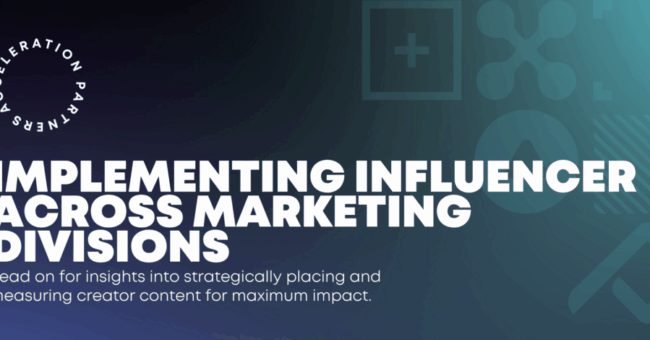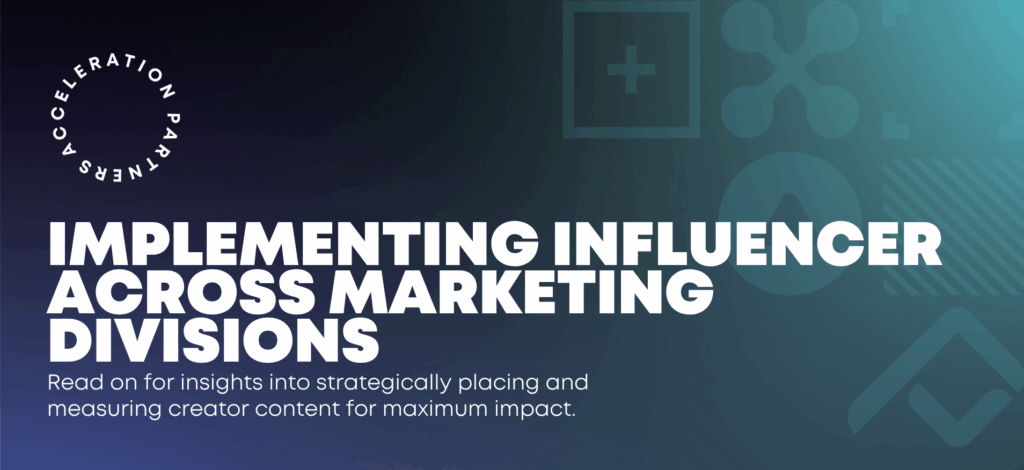

For many marketing teams, influencer activity still sits in a silo — often confined to organic social campaigns or treated as an experimental tactic rather than a core marketing driver. But brands seeing real success with influencer are doing something different: they’re embedding it across their marketing divisions, from performance to brand to retail, and seeing the results ripple throughout their entire strategy.
At Acceleration Partners, we help brands reimagine influencer as a scalable, measurable lever that supports the full marketing funnel. Implementing influencer across divisions doesn’t just improve content usage — it strengthens performance, drives creative consistency, and ultimately delivers better business results.
Strategic Placement: Making Creator Content Work Harder
One of the most significant shifts we have observed is in how and where influencer content is displayed. Traditionally, influencer content has been viewed as social content — sometimes repurposed but rarely central to broader marketing campaigns. That’s changing.
Leading brands are now thinking more broadly, proactively building creator content into paid ads, brand campaigns, email journeys, affiliate promotions, and even in-store visuals. This approach to influencer marketing isn’t about squeezing more value out of an asset — it’s about designing campaigns from the ground up that feature authentic creator content as a core creative element.
For example, usage rights are being negotiated upfront to allow paid media teams to run high-performing creator content as ads, email and CRM teams are incorporating influencer storytelling into product launches and retail teams are working influencer content into displays and partner campaigns. When content is used this way, influencer marketing shifts from being a one-time activation to an evergreen asset — adaptable, proven, and aligned with business goals.
Measuring Success: Rethinking What Impact Looks Like
Measurement often becomes the biggest challenge in getting influencer marketing out of its silo. Without shared KPIs across departments, it’s difficult to prove value in a way that resonates outside the social team.
That’s why the most forward-thinking brands are evolving their approach to evaluating influencer marketing success. Instead of relying solely on promo codes or last-click attribution, they’re looking at how creator content performs in comparison to branded content across paid channels, and how it drives conversions when used throughout the customer journey. Brand teams are examining its impact on storytelling and creative consistency, while performance teams are testing influencer-driven assets against traditional formats and tracking differences in ROAS and acquisition cost.
This broader lens allows influencer marketing to be considered alongside other marketing investments — and gives internal teams the confidence to prioritize it as part of their budget and strategy.
Breaking Down Silos: Influencer Belongs to Everyone
To truly implement an influencer strategy across marketing divisions, it must stop being seen as the responsibility of one team. Operational silos result in creative gaps — and brands that effectively integrate influencer marketing cross-departmentally are the ones who realize the potential of the channel.
We’ve seen success when brands embed influencer planning into annual campaign development alongside paid, affiliate, and brand teams. When influencer strategists are brought into early briefs and content planning sessions, they’re able to shape creative that solves real marketing challenges, not just social engagement targets.
The most effective programs are those where the influencer marketing strategy is treated as a content engine that supports multiple departments. Shared objectives, alignment on repurposing rights, and unified measurement frameworks all play a role in breaking down barriers and unlocking better performance. What starts as an influencer activation ends up fueling everything from upper-funnel storytelling to lower-funnel conversion — a true cross-functional asset.
Final Thought: Build for Integration, Not Isolation
Influencer marketing is most effective when it operates in conjunction with other marketing efforts. When embedded across divisions, it becomes a strategic lever that supports the whole marketing ecosystem. Creator content can drive results far beyond its initial post — but only if the infrastructure is there to support its distribution, usage, and measurement across the business.
At Acceleration Partners, we help brands evolve their influencer programs from isolated initiatives into integrated engines that deliver real impact. If your team is ready to move beyond the silo and turn influencer partnerships into a high-performing, revenue-generating channel, we’re here to help.